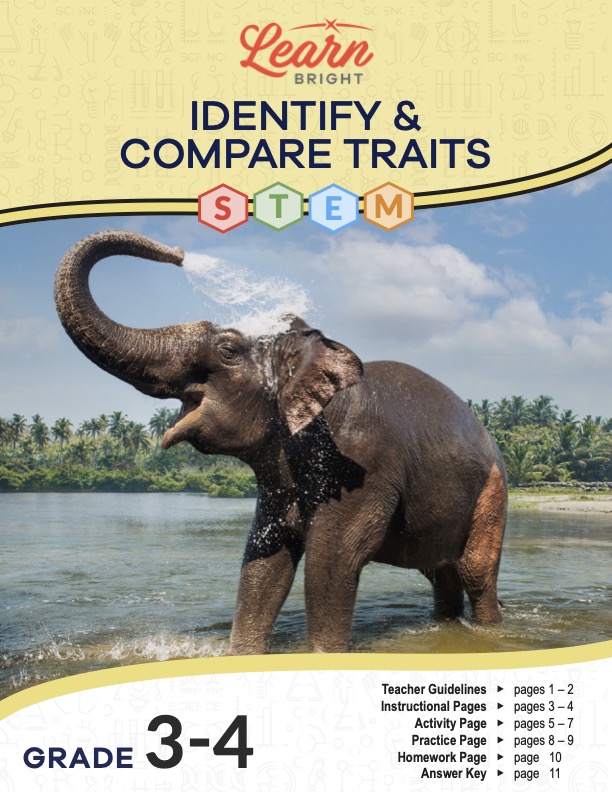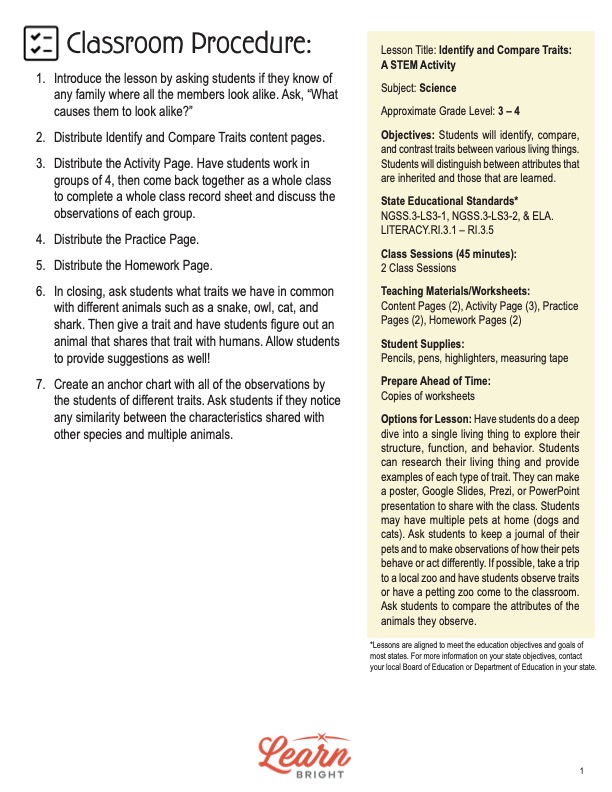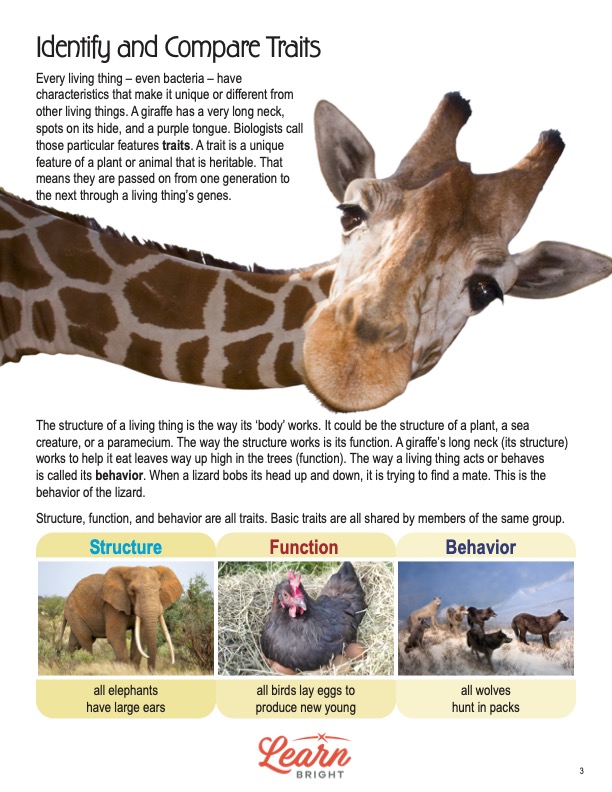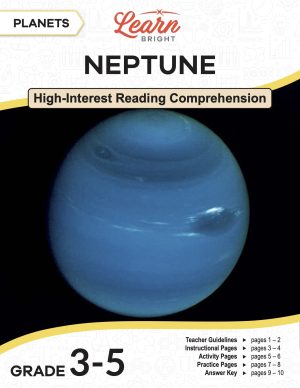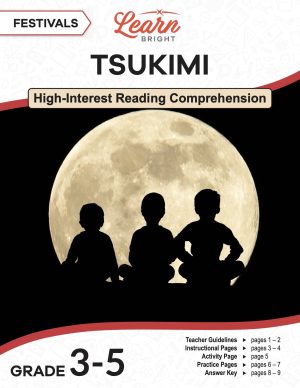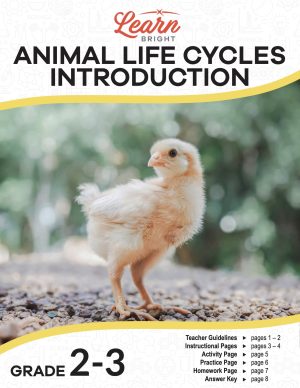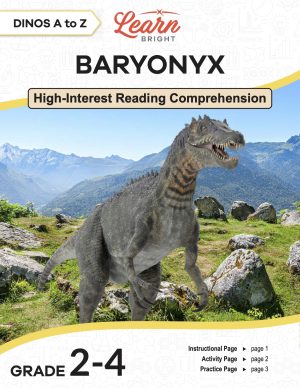Description
What our Identify and Compare Traits STEM lesson plan includes
Lesson Objectives and Overview: Identify and Compare Traits STEM explores the many different characteristics of various living things. Students will compare and contrast the traits of humans as well as those of animals. They will also discover the difference between the characteristics living things acquire and those they inherited from their parents. This lesson is for students in 3rd grade and 4th grade.
Classroom Procedure
Every lesson plan provides you with a classroom procedure page that outlines a step-by-step guide to follow. You do not have to follow the guide exactly. The guide helps you organize the lesson and details when to hand out worksheets. It also lists information in the yellow box that you might find useful. You will find the lesson objectives, state standards, and number of class sessions the lesson should take to complete in this area. In addition, it describes the supplies you will need and what and how you need to prepare beforehand. For this lesson, you will need pencils, pens, highlighters, and measuring tape.
Options for Lesson
The “Options for Lesson” section provides lots of additional suggestions for activities and ideas to add to the lesson. One idea is for students to “dive deep” into the traits of a single living thing to explore their structure, function, and behavior. Students could research their living things and provide examples of each type of trait. They could also make posters or slideshow presentations to share with the class. For students with multiple pets at home, assign them to keep a journal by recording what they observe about their pets. They could keep track of their differing behaviors. Another optional addition is to plan a field trip to a local zoo and have students observe the traits of different animals. You could also have a small petting zoo visit the classroom or school, and have students compare the attributes of the animals they observe.
Teacher Notes
The teacher notes page provides an extra paragraph of information to help guide the lesson and remind you what to focus on. It explains that this lesson focuses on human traits as well as the characteristics of various animals. The blank lines on this page are available for you to write out any thoughts and ideas you have as you prepare the lesson.
IDENTIFY AND COMPARE TRAITS STEM LESSON PLAN CONTENT PAGES
Structure, Function, Behavior
The Identify and Compare Traits STEM lesson plan contains two content pages. Students will first focus on the definition of a trait or characteristic and will learn that all living things have them. Even bacteria have traits that make them unique or different from other living things. A giraffe has a long neck, spots on its side, and a purple tongue.
Biologists call these features traits or characteristics, which they define as unique features of living organisms that are heritable. This means that traits can pass from one generation to another through that living thing’s genes. Students will learn that an organism’s structure refers to traits that dictate how its body works. The concept applies to plants, animals, and even a paramecium.
For instance, a giraffe’s long neck is part of its structure, and it works to serve a specific function (another type of trait). In this case, the structure of a giraffe’s neck helps it perform the function of eating leaves way high up in the trees. Behaviors are also a type of trait. A behavior is the way a living thing acts or behaves. When a lizard bobs its head up and down, that means it is trying to find a mate.
Basic traits of these kinds are shared by members of the same group. The lesson provides an example to illustrate structure, function, and behavior. For structural traits, it gives the example that elephants have large ears. The example that all birds lay eggs to produce new young represents functional traits. Finally, all wolves hunt in packs is an example of behavioral traits.
Physical Traits of Humans
The next page lists several common and easily comparable traits for humans. These include eye color, hair color, the presence of dimples, straight or curved thumbs, earlobe shape, and the ability to curl one’s tongue. It then provides a diagram with a few traits that organisms in each of the five animal classes share.
Fish breathe under water using gills instead of lungs (like mammals and other animal classes do). They also have scales and fins to help them swim in the water. Fish are cold-blooded and lay eggs. Similarly, reptiles are cold-blooded and have scales and not fur, but unlike fish, the skin of a reptile is dry instead of wet. In addition, not all reptiles lay eggs. Some give birth to live young.
Mammals, which include humans, give birth to live young, have hair or fur, and are warm-blooded. The mothers nurse their young with milk. Birds are also warm-blooded. However, a few characteristics that set them apart from other classes are that they have feathers and wings. Like fish and amphibians, and some reptiles, they also lay eggs.
Finally, amphibians share many of the same traits as other animal classes. They are cold-blooded and lay eggs. However, they can live both on land and in the water. They have moist skin and webbed feet that serve various important functions. Students will recognize through this diagram that many animals share similar traits but also have unique traits that set them apart.
IDENTIFY AND COMPARE TRAITS STEM LESSON PLAN WORKSHEETS
The Identify and Compare Traits STEM lesson plan includes three worksheets: an activity worksheet, a practice worksheet, and a homework assignment. Each one will reinforce students’ comprehension of lesson material in different ways and help them demonstrate when they learned. Use the guidelines on the classroom procedure page to determine when to distribute each worksheet to the class.
CLASS OBSERVATION ACTIVITY WORKSHEET
Students will observe their class, close friends, or family members to complete the activity. Reviewing the chart at the bottom of the page, they will predict the answers to the five questions. Each question relates to a different trait. After they have written their answers, they will begin observing the members of their group. The traits include eye color, tongue rolling, thumb bending, height, the presence of dimples, and long second toes. Students will fill out the recording chart on the next two worksheet pages.
IDENTIFY AND COMPARE TRAITS STEM PRACTICE WORKSHEET
For the practice worksheet, students will look at pictures of six animals. There are four traits beneath each picture. Students must circle which traits apply to the animal in each picture.
ANIMAL TRAITS HOMEWORK WORKSHEET
The homework assignment requires students to write out some traits for two different animals. Students can pick which animals they want to observe. They must write five traits that apply to each animal. Then, they will answer the question at the bottom of the page that asks which characteristics the two animals have in common.
Worksheet Answer Keys
There are answer keys for both the practice and homework worksheets. The correct answers are in red to make it easy to compare them to students’ work. Given the nature of the homework assignment, the correct answers are simply sample responses. If you choose to administer the lesson pages to your students via PDF, you will need to save a new file that omits these pages. Otherwise, you can simply print out the applicable pages and keep these as reference for yourself when grading assignments.

